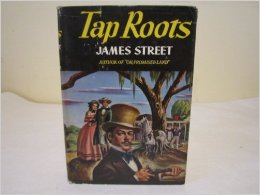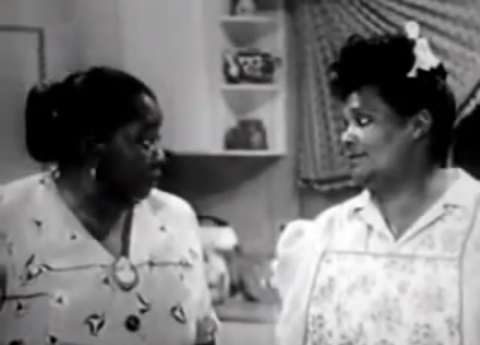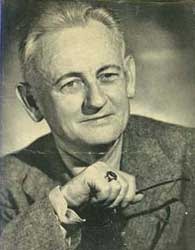by Vikki Bynum
As we await the release of The Free State of Jones, I thought it might be fun to visit an earlier movie similarly inspired by Newt Knight and the Knight band’s Civil War uprising. Tap Roots, adapted from James Street’s 1942 novel of the same name, was released by Universal International Pictures in August, 1948.

As I searched the internet, I quickly discovered that New York Times reviewer Tom Pryor had been anything but impressed by the movie. “Checking the accuracy of historical detail in Tap Roots, the romanticized Civil War drama,” he wrote, . . . “would serve no special purpose,” presumably because, he added, “clichés, oral and visual,” had produced a drama whose characters exhibited no “individuality or substance.”
Although I had read the novel Tap Roots many years ago, I had never seen the movie—until now. After viewing seven of the eight sections of Tap Roots on YouTube over the space of two days, I have to say, Pryor was right. Moviegoers learned little to nothing about the important story of Southern Unionism in Jones County, Mississippi, from this production. Sadly, its producer (Walter Wanger), director (George Marshall), and screenwriter (Alan Le May) preferred the tried and true visuals of battlefield scenes—juxtaposed with star-crossed lovers who suffer simultaneously from unrequited love, personal betrayal, and brutal warfare—to the complicated historical terrain of Southern Unionism.
The movie makers treated viewers to a sort of poor man’s Gone with the Wind—except that Hoab Dabney himself (the cinematic version of Newt Knight) appeared as anything but poor, living in his recently-departed father’s opulent mansion with slaves that he apparently inherited from dad! Never mind that neither the real Newt Knight—nor his father—owned slaves. I had to laugh, though, when Hoab Dabney first appeared on screen. Veteran actor Ward Bond appears as a wealthy, middle-aged Hoab, complete with mutton-chop sideburns, a crisp white shirt, black vest and cravat, and sporting a gold watch chain that hangs fetchingly across his portly mid-section!
Let’s just say that Ward Bond is no Matthew McConaughey. . . .
What were Tap Roots’ filmmakers thinking, you ask? They were thinking of Gone with the Wind, that’s what. Never mind that that wildly successful movie was dedicated to the principles of Lost Cause history, with its images of a solid white South and happy slaves. The plot lines, clichés, and characters of Gone with the Wind were shamelessly borrowed, but with a twist—and it’s only a twist—of Southern white opposition to secession from the Union. There is no people’s movement here—only the Dabneys’ assertion of their “freedoms” and dominion over their beloved Lebanon Valley. The men who join the provincial, hardheaded Dabneys in asserting their individual prerogative to remain “neutral” during the war display no agency and no ideas; they merely follow. Although the phrase, “rich man’s war and poor man’s fight,” is briefly flashed on the screen, it has no relevance to the story presented.
Likewise, and despite the fact that racial segregation and civil rights were burning issues during the 1940s, Tap Roots broke no new ground on issues of race, totally ignoring the interracial community founded by Newt, Serena, and Rachel Knight. Only the movie’s hero, newspaper editor Keith Alexander (played by Van Heflin), offered a vague criticism of slavery, while the Dabney family slave, Dabby (played by Ruby Dandridge), joined a long line of “Mammy” clones inspired by Gone with the Wind.

The movie’s main characters—talented though many of the actors were—demonstrated the shallowness of vision that kept Tap Roots from becoming the classic film it might have been. Opening scenes that depict the death of patriarch “Big Sam” Dabney (father of Hoab) are promising enough, but the movie quickly comes to center on Sam’s granddaughter, Morna, played by Susan Hayward. Hayward, who had unsuccessfully auditioned for the role of Scarlett O’Hara in Gone with the Wind a decade earlier, got her second chance at playing a plantation belle. Not only is she dolled up to resemble Scarlett, her scenes with Dabby echo those of Scarlett and Mammy from the previous decade.

Perhaps in further homage to Scarlett, the film gave Morna Dabney far greater importance to the story than that of her father, Hoab. Befuddled, stubborn, and selfish, Hoab is everyone’s problem. It is Keith Alexander who instead becomes the male hero of Tap Roots. The dashing newspaperman ultimately wins the love of Morna despite her desperate longing for unattainable Confederate officer, Clay McIver. The early scenes of Morna’s obsession for Clay, countered by Keith’s forceful attempts to seduce her, are ridiculously reminiscent of the Scarlett O’Hara/Ashley Wilkes/Rhett Butler love triangle of Gone with the Wind.
Really, it’s all too much to bear: a story as historically important as the Free State of Jones reduced to an unoriginal Romance-Amid-the-Horrors-of-War spectacle in a movie that barely musters a plot!
In fairness to the movie, the novel Tap Roots did not hew to the facts of Jones County’s inner civil war either. Rather, author James Street infused his characters with ideas and actions for which there was no historical proof—as novels (and movies) must do to build an exciting and satisfying story. While Street admitted that the character of Hoab Dabney was “inspired” by tales he’d heard about Newt Knight as a child, whom he described as a “rather splendid nonconformist,” he never claimed that Hoab was strictly based on Newt. Moreover, he suggested that he wrote Tap Roots as fiction because strict adherence to facts and names would be too controversial for the living.
Accordingly, Street jumbled up the genealogies and generations wherever characterizations of possibly real people appeared. For reasons known only to him, he made Hoab Dabney the son of Big Sam, who seems patterned after Newt Knight’s slaveholding grandfather, Jackie Knight, rather than his nonslaveholding shoemaker father, Albert. As a result, the story is less about a class uprising among nonslaveholding farmers than it is about eccentric patriarchs who recognize only their own authority.
Despite its limits, and in distinct contrast to the movie, the novel Tap Roots stimulated the imaginations and intellect of readers as well as appealing to their unquenchable thirst for battlefield gore and harlequin romances. Most particularly, Street stressed the existence throughout the South of white hatred for slavery and the Confederacy. Without delving into the factual elements of the interracial Knight community, he nonetheless discussed throughout his story the mixing of blacks and whites that had occurred throughout the South’s history. Street was determined to introduce readers to a different South than the one portrayed in novels and movies such as Gone with the Wind.
What, then, must James Street have thought of the movie version of his novel?




[…] Tap Roots (1948): A Review of the first “Free State of Jones” movie […]
LikeLike
Hi Vikki,
Indeed, you have an abundance of talent. I LOVE reading all of your commentaries. Great story telling. In particular, I’m commenting on your personal take of both the movie ‘Tap Roots’ and also the novel. Very interesting indeed, Many thanks….And while I had read a similar take ten or so years ago, the composer lacked your erudite prose. Vikki, I am literally thrilled for you and for your hunk man husband Gregg too, knowing that all of your collective efforts have resulted in the production of a soon to be released (no doubt) a great movie. WOW!
Your forever fan in San Diego,
The other Vikky … older too.
LikeLiked by 1 person
[…] me conclude with an excerpt from Victoria Bynum’s take on “Tap Roots”, which is contained on her invaluable website Renegade […]
LikeLike
Saw Tap Roots last night on You Tube. I hadn’t yet read this blog post, but knew that it was somewhat based upon the story of Newt Knight. I did, however, know just a little bit about the Dabney family, and so I knew right off that it was a conflated story of two stories. I agree with your synopsis, entirely, including especially Susan Hayworth’s role (bringing in reminders and flashbacks to yet a third story of GWTW). But – it’s the 1940’s, and for it’s time its concepts had to have been enormously controversial – even if the telling of it in the movie was garbled. As you know, only in this time are we unraveling the “tap roots” of so many of these families. Here’s another one, Victoria, that is tied to the Dabneys, and many of us have worked for years to unravel the relationships, but have not yet met with success. Still working on it. http://files.usgwarchives.net/la/rapides/cemeteries/nealcem.txt
LikeLiked by 2 people
Hi Bev, thanks for commenting!
You are certainly correct that the movie’s theme—white southerners who opposed the Confederacy—was still quite controversial in the 1940s. But Southern Unionism was the entire premise on which James Street based his novel, Tap Roots (1943)! So why would Hollywood even make the movie if it had no interest in meaningfully engaging the issue? Even the 1940 John Wayne movie, Dark Command, addressed (however imperfectly) the novel of the same name’s historical theme of guerrilla warfare between Confederates and Unionists in Civil War Kansas.
For the producers of Tap Roots to do nothing with either the nonslaveholding whites who built and participated in this uprising, and to totally ignore the racial issue that runs throughout Street’s novel—beyond including a black “Mammy” figure who cries when the slaveholding Dabney’s son dies during the Civil War—was a total negation of the book’s plot and purpose. Street, who specifically wrote it for the screen in order to offer an alternative to Gone with the Wind, was justifiably upset by the mess created by Universal in its efforts to capitalize on the very movie whose message he hoped to contradict.
Of course, racism, segregation, and the Lost Cause version of the Civil War were still deeply entrenched during the 1940s, but all were being forcefully challenged at that very moment by civil rights activists, historians, and Film Noir moviemakers. So it was certainly possible to choose a different path in this transitional decade. But don’t get me wrong. I agree that it was too early to expect a full-blown treatment of Southern Unionism or race-mixing in the Civil War South; I just expected better than the pathetic movie Tap Roots.
I think it comes down to money. Gone with the Wind was the most successful movie ever, and Universal shamelessly sought to exploit its major themes no matter how much they corrupted the very core of James Street’s novel of the same name.
Vikki
LikeLiked by 1 person
Hi, Vicky.
I am from Venezuela. My friends from Inland Empire CWRT along with other CWRTs from Southern California, with whom I have attended in several of their online meetings since the beginning of last year, are organizing an event with author Victoria Bynum next month, which I already registered for and even shared the information on my Facebook group about the Civil War for the Spanish-speaking public.
In the group, someone commented on the movie “Raíces de Pasión” just a few days ago, which is how “Tap Roots” is known in my language. I had no idea that such a film existed. I immediately added it on a list of movies about the Civil War that we have in the group, that we try to promote so that people can see and enjoy them, and yesterday I searched for it and got it in my language from a Spanish TV channel, and I saw it last night.
As I saw certain similar details with the movie “Free States of Jones”, I started to think if both were taken from the same story, told in a very different way and even opposite in its essence or were totally different stories, but It already seemed strange to me that they were both from the same state, Mississippi. And I just came across this blog, which I read completely read the article and at the end, I realized that it is written by the same person that I will soon be able to have as a speaker at an event. Now with more reason I will attend it. Only I’ll have to watch both movies more carefully before that event. I haven’t read any of the books to be honest, it’s not that easy for me either. Thanks for clearing up a bit of that about the movie “Tap Roots” vs. the real story.
LikeLike
Hello, Fernando (If I may so address you),
How perfect that you discovered my blog because of your interest in my upcoming presentation for the Southern California CWRTs!
I’m pleased that you have watched AND read my review of the movie Tap Roots. I read James Street’s book, Tap Roots, when I first began researching The Free State of Jones, but I did not see the movie version you just watched until years later–even after the movie Free State of Jones appeared! Yes, please watch both movies now that you know they are about the same event. And if it’s not too difficult given that English is not your first language, I hope you’ll read my book on the Free State of Jones as well.
I’m looking forward to our June 26 event very much! And to meeting you, so please try to introduce yourself during the Q & A session.
Best,
Vikki Bynum
LikeLiked by 1 person
Thank you, Vikky.
That encourages me to do a task for this week. Watch both movies again and read your articles from your blog. and write reviews of both films and post them in my Civil War group and in a good number of Film groups in Spanish on Facebook, of which I have already joined. Something I started doing about 2-3 months ago to promote our events in Spanish.
LikeLiked by 1 person